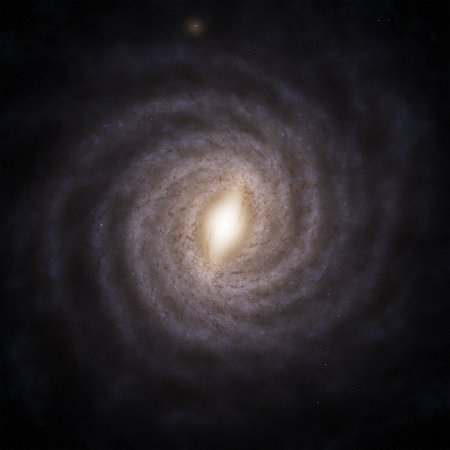eROSITA – first glimpse into the hot universe

Figure 1: Our neighbouring galaxy, the Large Magellanic Cloud, observed in a series of exposures with all seven eROSITA telescope modules taken from 18 to 19 October 2019. The diffuse emission originates from the hot gas between the stars with temperatures of typically a few million degrees. The more compact nebulous structures in the image are mainly supernova remnants. The most prominent one, SN1987A, is seen close to the center as a bright source which appears punctate due to the great distance.
Credit: F. Haberl, M. Freyberg, C. Maitra, MPE/IKIThe German space telescope eROSITA has now published the first astounding images of the hot universe. With all seven “X-ray eyes” it targeted a rare neutron star, the Large Magellanic Cloud and interacting galaxy clusters.
The X-ray telescope eROSITA (extended ROentgen Survey with an Imaging Telescope Array), the main instrument of the Russian-German Spectrum-X-Gamma (SRG) mission, which was successfully launched in July, has now reached its orbit around Lagrange Point 2, 1.5 million kilometers behind Earth when viewed from the Sun, after a flight time of more than three months. From here, eROSITA will begin a survey of the entire sky to produce a map of the hot structures in the universe that emit X-rays due to their high temperature.
eROSITA consists of seven individual telescope modules that collect the incident X-ray light from the hot sources of the universe. Initially, only individual components were switched on and their functionality was carefully checked step by step. At first, individual telescope modules showed anomalies. Cosmic radiation is suspected of being the “culprit”, which could have triggered small changes in some components. By now, eROSITA has gone into operation after a short delay and tests.
In its full configuration, i.e. operated with all seven cameras, eROSITA was first aligned toward an object proposed by AIP (Figure 2). Project manager Axel Schwope explains why exactly this object was selected: “It is a very exotic object, Pulsar PSR B0656+14, a rapidly rotating isolated neutron star, which is best visible in X-ray light due to its small size and its enormously high temperature of more than one million degrees.” Such objects are extremely rare, about 30 are known, but they allow fundamental physical insights into cosmic laboratories. Neutron stars like PSR B0656+14, which only needs one third of a second for a full rotation, has a diameter of only about 30 km and a mass of about one and a half solar masses, may also be described as macroscopic atomic nuclei. In total, eROSITA observed the pulsar for 28 hours. At the same time, the European X-ray satellite XMM-Newton also targeted the object. The combined observation allows new, unique insights into the magnetic field and the temperature distribution of the neutron star. “Both instruments cooperate wonderfully. Thanks to the high spectral and temporal resolution now available, we can obtain a spectrum at each moment of rotation that provides information about the extreme physics of a neutron star,” explains Schwope.
In our neighboring galaxy, the Large Magellanic Cloud, eROSITA not only shows the distribution of diffuse hot gas, but also some remarkable details, such as supernova remnants like SN1987A (Figure 1). The eROSITA observations now confirm that this source is becoming fainter, as the shock wave produced by the stellar explosion observed in 1987 expands through the interstellar medium. In addition to a host of other hot objects in the Large Magellanic Cloud itself, eROSITA also reveals a number of foreground stars from our own Milky Way galaxy as well as distant active galactic nuclei, whose radiation pierces the diffuse emission of the hot gas in our neighboring galaxy.
A particular focus of eROSITA is the discovery and mapping of galaxy clusters. These clusters bind the extremely diluted gas from their surroundings, which is invisible to our eyes, by gravity. Through compression and turbulence, the gas heats up and radiates intensively in the X-ray range. Among eROSITA’s first images are the interacting galaxy clusters A3391 and A3395 (Figure 3). The two clusters, which appear in the images as large elliptical nebulae, extend over millions of light years and contain thousands of galaxies each. During its 4-year X-ray survey, eROSITA will discover and map about 100,000 galaxy clusters and several million active black holes in the centers of galaxies.
The German X-ray telescope eROSITA was developed and built with the support of DLR Space Management by the Max Planck Institute for Extraterrestrial Physics in Garching together with the Leibniz Institute for Astrophysics Potsdam (AIP) and the universities of Erlangen-Nuremberg, Hamburg and Tübingen. The universities of Munich and Bonn also participated in the science preparation for eROSITA. The partner institutes have developed software for data analysis, mission planning and simulations and provided parts of the hardware. The Russian partner Institute is the Space Research Institute IKI in Moskow; NPOL, Lavochkin Association, in Khimky near Moskow, is responsible for the technical implementation of the whole SRG mission, which is a joint project of the Russian and German space agencies, Roscosmos and DLR.
Images
Figure 1: Our neighbouring galaxy, the Large Magellanic Cloud, observed in a series of exposures with all seven eROSITA telescope modules taken from 18 to 19 October 2019. The diffuse emission originates from the hot gas between the stars with temperatures of typically a few million degrees. The more compact nebulous structures in the image are mainly supernova remnants. The most prominent one, SN1987A, is seen close to the center as a bright source which appears punctate due to the great distance.
Big screen size [1000 x 936, 110 KB]
Original size [1141 x 1068, 140 KB]
Figure 2: Pulsar PSR B0656+14, an isolated and rapidly rotating neutron star about 900 light years from Earth. The observation nicely illustrates the survey power of eROSITA through its large field of view, about twice as large as that of XMM-Newton, which thus uncovers many previously unidentified X-ray sources surrounding the pulsar: hot stars in the Milky Way (mostly greenish sources) and distant active galactic nuclei (mostly bluish sources).
Figure 3: The two interacting galaxy clusters A3391, above, and A3395, below, observed in a series of exposures with all seven eROSITA telescope modules taken from 17 to 18 October 2019. The individual images were subjected to different analysis techniques, and then colored in different schemes to highlight the different structures. In the left-hand image, the red, green and blue colours refer to the three different energy bands of eROSITA. One clearly sees the two clusters as nebulous structures, which shine brightly in X-rays due to the presence of extremely hot gas (tens of millions of degrees) in the space between galaxies. The image on the right highlights the “bridge” or “filament” between the two clusters, confirming the suspicion that these two huge structures actually do interact dynamically. The eROSITA observations also show hundreds of point-like sources, signposting either distant supermassive black holes or hot stars in the Milky Way.
Big screen size [1000 x 575, 800 KB]
Original size [1400 x 806, 1.4 MB]





